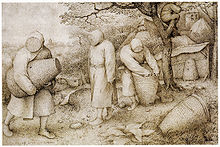Bee Keeping History
Posted On Thursday, November 21, 2013 at at 5:01 AM by All best knowledgeBee Keeping
Beekeeping (or apiculture, from Latin apis, bee) is the maintenance of honey bee colonies, commonly in hives, by humans. Abeekeeper (or apiarist) keeps bees in order to collect honey and other products of the hive (including beeswax, propolis, pollen, androyal jelly), to pollinate crops, or to produce bees for sale to other beekeepers. A location where bees are kept is called an apiary or "bee yard".
Depictions of humans collecting honey from wild bees date to 15,000 years ago, efforts to domesticate them are shown in Egyptian art around 4,500 years ago. Simple hives and smoke were used and honey was stored in jars, some of which were found in the tombs ofpharaohs such as Tutankhamun. It wasn't until the 18th century that European understanding of the colonies and biology of bees allowed the construction of the moveable comb hive so that honey could be harvested without destroying the entire colony.
History of Bee Keeping
At some point humans began to attempt to domesticate wild bees in artificial hives made from hollow logs, wooden boxes, pottery vessels, and woven straw baskets or "skeps". Honeybees were kept in Egypt from antiquity.[2] On the walls of the sun temple ofNyuserre Ini from the Fifth Dynasty, before 2422 BCE, workers are depicted blowing smoke into hives as they are removinghoneycombs.[3][4] Inscriptions detailing the production of honey are found on the tomb of Pabasa from the Twenty-sixth Dynasty (c. 650 BCE), depicting pouring honey in jars and cylindrical hives.[5] Sealed pots of honey were found in the grave goods of pharaohs such as Tutankhamun.
There was an unsuccessful attempt to introduce bees to Mesopotamia in the 8th century BCE by Shamash-resh-ușur, the governor of Mariand Suhu. His ambitious plans were detailed in a stele of 760 BCE:[4]
In prehistoric Greece (Crete and Mycenae), there existed a system of high-status apiculture, as can be concluded from the finds of hives, smoking pots, honey extractors and other beekeeping paraphernalia in Knossos. Beekeeping was considered a highly valued industry controlled by beekeeping overseers—owners of gold rings depicting apiculture scenes rather than religious ones as they have been reinterpreted recently, contraSir Arthur Evans.[7]
Archaeological finds relating to beekeeping have been discovered at Rehov, a Bronze and Iron Age archaeological site in the Jordan Valley, Israel.[8]Thirty intact hives, made of straw and unbaked clay, were discovered by archaeologist Amihai Mazar of the Hebrew University of Jerusalem in the ruins of the city, dating from about 900 BCE. The hives were found in orderly rows, three high, in a manner that could have accommodated around 100 hives, held more than 1 million bees and had a potential annual yield of 500 kilograms of honey and 70 kilograms of beeswax, according to Mazar, and are evidence that an advanced honey industry existed in ancient Israel 3,000 years ago.[9] Ezra Marcus, an expert from the University of Haifa, said the finding was a glimpse of ancient beekeeping seen in texts and ancient art from the Near East.[10][11]
In ancient Greece, aspects of the lives of bees and beekeeping are discussed at length by Aristotle. Beekeeping was also documented by theRoman writers Virgil, Gaius Julius Hyginus, Varro, and Columella.
The art of beekeeping appeared in ancient China for a long time and hardly traceable to its origin. In the book "Golden Rules of Business Success" written by Fan Li (or Tao Zhu Gong) during the Spring and Autumn Period there are some parts mentioning the art of beekeeping and the importance of the quality of the wooden box for bee keeping that can affect the quality of its honey.
The ancient Maya domesticated a separate species of stingless bee.

Post a Comment